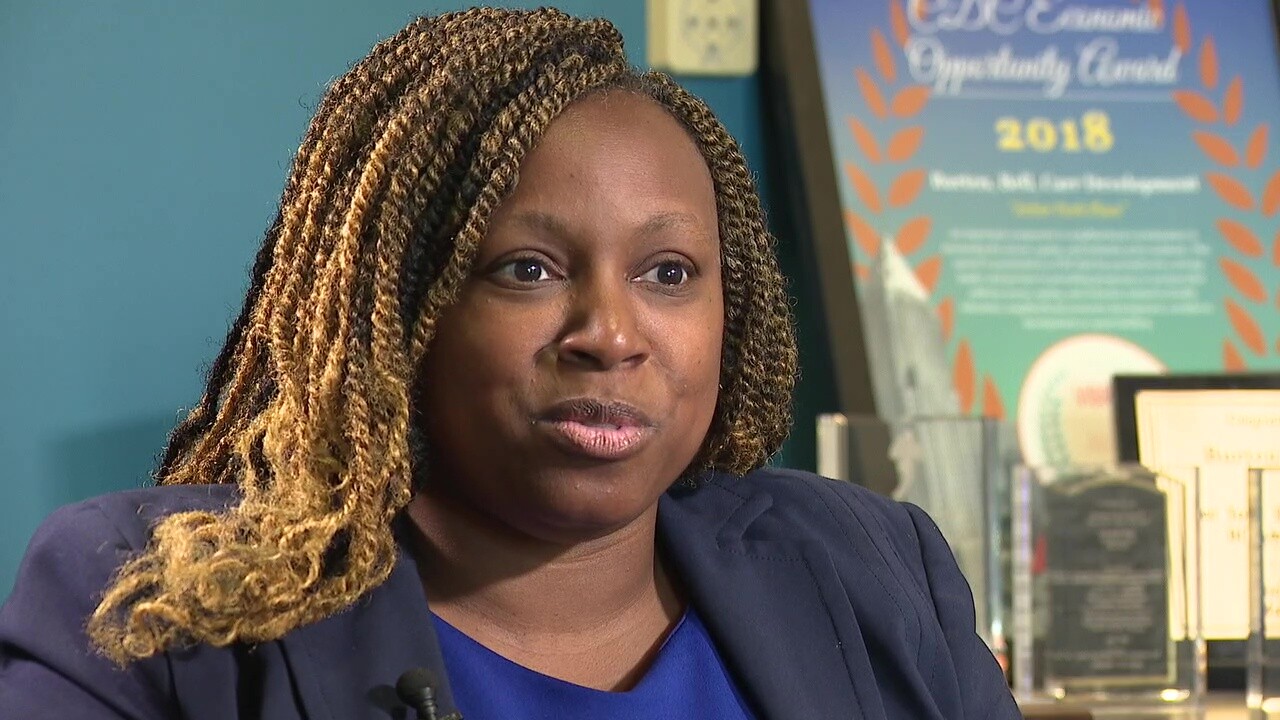CLEVELAND — An $18 million plan to revive Buckeye Road, a struggling commercial corridor that links Cleveland to the inner-ring suburbs, is gaining momentum.
Cleveland City Council recently awarded $3.88 million to the project. That money will kickstart renovations at a handful of vacant buildings, including the historic Moreland Theater – an anchor for a proposed district devoted to Black culture, arts and innovation.
Construction is likely to start next summer. But there’s already lots of activity happening behind the scenes.
“The challenge in this work is that the construction is usually the last step – and it’s the easiest step. But it’s the step that everybody can see,” said Joy Johnson, executive director of Burten, Bell, Carr Development Inc., the nonprofit shepherding the project.
Burten, Bell, Carr owns 10 buildings on the street – properties that the community development corporation has purchased or acquired out of tax foreclosure. They’re vacant today, with gray boards nailed over the storefronts and blank windows upstairs.
The largest of them is the theater, which opened as a movie palace and vaudeville house in 1928. It’s been languishing for decades now, with peeling paint in the lobby and sunlight flickering through the water-damaged western wall.

A committee convened by the Cleveland Restoration Society is studying what it will take to rehabilitate the property, which has been everything from a Hungarian venue to a dance hall to a church.
“I feel like it should become a place where we can see Black arts and culture come alive,” Johnson said Thursday while standing inside the hushed space. “In my dreams, there’s music. There’s dancing. There’s theater.”
Part of the $3.88 million from the city – a forgivable loan – will help to restore the northern section of the building, with storefronts along the street and offices upstairs. Renovating the performance space will require more time and money.
“Our goal is to sort of put the theater on ice, so to speak, and make sure that it stays in good condition while we continue to fundraise for the bigger lift,” said Johnson, who is talking to prospective tenants she can't identify yet.

Earl McNary grew up in the area and has run a barbershop on Buckeye Road for years. He’s never been in the old theater – but he’s intrigued.
“I don’t know what they’re gonna do with it, but I’d love to see it back open,” he said.
From Earl’s Xclusive Cuts, he’s watched many other small businesses disappear. But he’s stayed and reinvested in his space, supported by clients who live nearby.
“I’ve got faith in Buckeye,” he said Thursday. “I think it’s gonna come back.”
Historic preservation is a huge part of that turnaround plan.
The Moreland Theater is already listed on the National Register of Historic Places. It qualifies for valuable federal and state tax credits for preservation.

And Burten, Bell, Carr has been working to get a stretch of Buckeye Road designated as a national historic district to make more properties eligible for tax credits.
The National Park Service is reviewing the listing, a process that typically takes a few months. The Buckeye Commercial Historic District would run from East 112th Street to East 128th Street and span 90 buildings, most of them constructed between 1900 and 1974.
Those buildings tell the story of the Hungarian immigrants who once flocked there, creating an ethnic enclave that flourished for decades, and the Black families who started to replace them during the Great Migration from the rural South.
The prospect of losing that history spurred community groups and public officials to act.
“It was really at a tipping point, where if there wasn’t attention and investment paid to Buckeye Road, it could begin to look like so many of our other commercial corridors where the buildings end up being demolished and we just have vacant lots. And we have to start from scratch,” Johnson said.

The city flagged Buckeye Road as a high-priority investment area before the pandemic as part of then-Mayor Frank Jackson’s Neighborhood Transformation Initiative.
The money the city just committed to the corridor actually came from that program – cash that had just been sitting, said Tom McNair, the city’s economic development director.
“Every single neighborhood in the city of Cleveland has its assets. It has things we can build around,” McNair told members of the City Council during a public hearing in June.
“When we look at revitalizing the existing commercial corridors and the buildings that already exist, it is a chance to create naturally occurring affordable housing,” he said. “It’s a chance to make extensive impact, right? And a far more economical way of doing it.”
The city recently spent $4.5 million repaving part of the road and fixing up sidewalks.
The other money for the Buckeye Road project will come from public, private and civic sources. Burten, Bell, Carr is still raising funds and planning a capital campaign.

Johnson cautioned that this won’t be a swift process. It could take 5 to 10 years to transform all of the nonprofit’s buildings, creating a foundation for other investors to build on while creating spaces for low-income renters and Black entrepreneurs.
“We’ve talked with folks from other parts of the country that have been involved in … projects similar to this, and they said that they’ve taken as much as 30 years,” she said. “And I was like, ‘We don’t have that kind of time. We’ve got to move a little bit faster.’”
The district sits just south of Shaker Square, a historic shopping center at the edge of the Cleveland-Shaker Heights border. Burten, Bell, Carr is a part-owner of that property through a partnership with Cleveland Neighborhood Progress. The nonprofits teamed up in 2022 to buy the Square out of foreclosure with the city’s help.
Johnson lived in the Buckeye Road area for years and raised her daughter there. She used to drive the street every day – and wish for more resources for her neighborhood.
“We are committed,” she said. “There is a group of residents and investors and elected officials that care about Buckeye. And you may not see the results right away. But know that we’re working hard to make a difference. On Buckeye Road. And in the entire community.”





